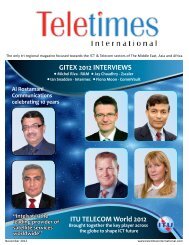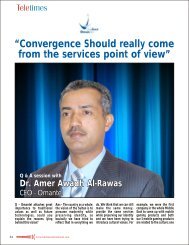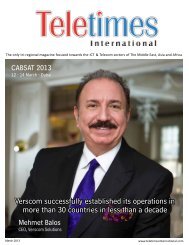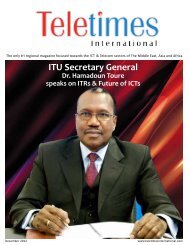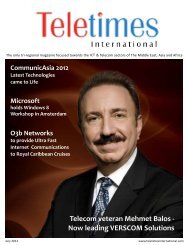You also want an ePaper? Increase the reach of your titles
YUMPU automatically turns print PDFs into web optimized ePapers that Google loves.
Asif MehmoodChief Executive OfficerUnicom Pakistan (Pvt) Ltd.Masud KamalDirector OperationsUnicom Pakistan (Pvt) Ltd.Arif KamalDirector Finance & ProjectsUnicom Pakistan (Pvt) Ltd.Deeba GilaniCompany SecretaryUnicom Pakistan (Pvt) Ltd.Communication Technologies(ICTs) to create an efficientGovernment aimed atsimplifying procedures,bringing transparency,accountability and makingtimely information available toall citizens.To achieve the above, theMinistry of ICT, identifiedtwo enabling priority actions;namely: the establishmentof the E-GovernmentInfrastructure (EGI) and theestablishment of the NationalData Transmission BackboneInfrastructure (NBI).Subsequently, a CommercialContract was signed betweenthe Ministry of Information andCommunications Technology(ICT), Uganda and HuaweiTechnologies Co. Ltd of thePeoples Republic of China. TheContract Works for the overallproposed project included allequipment, imported plant &materials, civil works and allservices.Phase 1 of the project whichstarted in May 2007 wascompleted by the end ofApril 2008. In Phase 2 workshave been completed whiletesting and commissioning is inprogress.Objectives of the project:The main objectives of theproject are to.Establish a National backboneand connect all Ministries ina single Wide area network.In this regards, videoconferencing services rolledout in all Ministries. Kampala,Entebbe, Bombo. Mukonoand Jinja connected tonational backbone.183 Km ofoptical fibre cable laid and 20Districts connected to nationalbackbone.TT: How can GIS based systemassist in Disaster management,Health and Telecommunicationservices? What are itsprospects and applications inAfrican States?AM: Earth Observation System(EOS) used for Remote Sensingin conjunction with GeographicInformation System (GIS) areamong many tools availableto disaster managementpractitioners. Satellite imagesenable disaster managersto have a broad overview ofthe environmental situationacross a wide area. The scaleof view from space rangesfrom entire continents todetail of a few meters. Thus,many types of disasters, suchas floods, droughts, cyclones,volcanic eruptions, etc. willhave certain precursorsthat satellite can detect.Remote sensing also allowsmonitoring the event duringthe time of occurrence. Thevantage position of satellitemakes it ideal for obtaininga big picture of the disasterthereby facilitating effectivemonitoring of the event GISis a system that captures,stores, analyzes, manages, andpresents data that are linkedto geographical locations.In the simplest terms, GIS isthe merging of cartography,statistical analysis, anddatabase technology. Thus, GISis a necessary complement toRemote Sensing and it is usefulat every phase of disastermanagement.Over the years, naturaldisasters have remained anenormous challenge to mostcountries in Africa. Incidentssuch as drought, famine,floods, oil spillage and wildfiresoften plague various countriesacross the continent. Thesedisasters, particularly thoserelated to meteorological, hydrologicaland climatic hazardsare increasing across the continent.The situation is worsenedby unplanned and unregulatedland use, weak environmentalcontrols, poor enforcement ofbuilding standards, urbanization,and other developmentlinkedfactors that increasethe vulnerability of people,property, and infrastructure.Africa has been receiving globalattention in various aspectsof disaster control. There areseveral notable internationalorganizations taking advantageof space systems in managingdisasters in the continent.Although GIS was initiallydeveloped for physicalgeographic application, it canbe used for the managementand analysis of healthand health-care data. GIS,combined with participatorymethodology, has facilitatedthe analysis of access to healthfacilities and disease risk indifferent populations and inplanning for health and socialcare. Hightower show that itis feasible to use GeographicalPositioning Systems (GPS) toproduce highly accurate mapsof communities illustratingaltitude of houses, positionsof health-care centres andmosquito breeding sites as wellas other geographical variablesof interest in their longitudinalstudy of malaria in Kenya.Many current applications ofGIS in the telecommunicationsindustry began asdepartmental tools thatworked within a well-defined<strong>October</strong> <strong>2012</strong>www.teletimesinternational.com31





